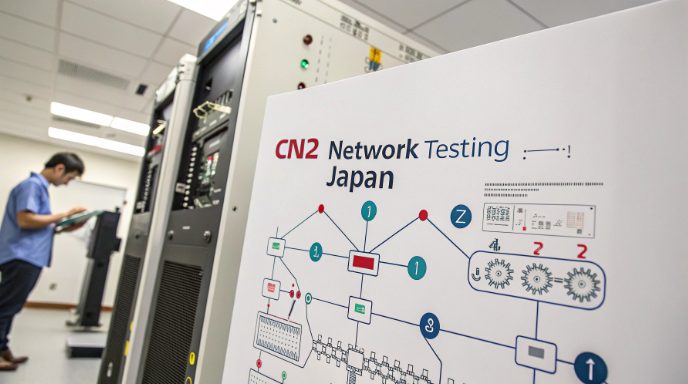How to Test the Actual Network Quality of Japan CN2 Lines?

Introduction: The Significance of Testing Japan CN2 Network Quality
For tech professionals engaging in cross-border infrastructure or low-latency service deployments, understanding the real-time performance of Japan CN2 lines is critical. CN2, China Telecom’s next-generation bearer network, is designed to offer optimized routing, reduced latency, and enhanced bandwidth stability. However, the market often sees misrepresented “CN2” offerings, making rigorous testing essential to validate service authenticity and suitability for specific use cases, such as hosting, colocation, or real-time data transmission.
Basic Testing: Assessing Connectivity and Latency
Start with fundamental diagnostics to establish baseline performance metrics:
1. Ping Testing for Latency and Stability
The most straightforward method to gauge network responsiveness involves using the built-in ping utility. Here’s a step-by-step approach:
- Access the command line interface on your system (CMD for Windows, Terminal for macOS/Linux).
- Execute the command with the server IP:
ping [Japan CN2 server IP] -tfor continuous testing. - Monitor key metrics: average latency in milliseconds and packet loss rate. A quality CN2 line should exhibit sub-100ms latency and less than 1% packet loss under normal conditions.
2. Route Tracing with Traceroute
Traceroute helps visualize the data path from your device to the Japan CN2 server, revealing potential routing inefficiencies:
- Use cross-platform tools like MTR or equivalent command-line utilities.
- Analyze the route for CN2 networks indicators, such as IP segments starting with
59.43.or202.97.. - Beware of routes that detour through non-CN2 nodes (e.g., via the U.S. or Southeast Asia), which can introduce unnecessary latency.
Advanced Testing: Bandwidth, Stability, and Performance Depth Dive
Move beyond basic checks to evaluate performance under real-world loads:
1. Bandwidth Throughput Measurement
Accurate bandwidth testing is crucial for workloads requiring high data transfer rates:
- Utilize international bandwidth testing platforms, ensuring you select a Japan-based CN2 node.
- Conduct multiple tests at different times (e.g., off-peak and peak hours) to account for network congestion.
- Record both upload and download speeds, with optimal results varying by service tier but generally exceeding 50Mbps for download and 30Mbps for upload in standard configurations.
2. Long-Term Stability Evaluation
Sustained load testing reveals how the network performs under prolonged usage:
- Employ professional tools to simulate continuous data transfer, such as large file transfers or streaming protocols.
- Monitor for latency spikes and bandwidth fluctuations using visualization tools that plot real-time performance metrics.
- Assess whether periodic delays occur, which could impact time-sensitive applications like live streaming or interactive services.
Real-World Application Testing: Simulating Operational Scenarios
Translate technical metrics into practical performance evaluations for specific use cases:
1. Web Performance Testing
Evaluate how quickly content loads from the Japan CN2 server for end-users:
- Use website performance tools with testing nodes located in China to mimic target user locations.
- Focus on key metrics: first-contentful-paint time (ideally < 3 seconds) and full page load completion (aim for < 5 seconds).
- Analyze resource loading sequences to identify bottlenecks in CSS, JavaScript, or media files.
2. Live Streaming and Video Push Testing
For media-intensive applications, test real-time data transmission quality:
- Use streaming software to push high-definition video (e.g., 1080p) to the server.
- Monitor for frame rate drops, encoding errors, and end-to-end latency (target < 500ms for interactive streams).
- Assess bitrate stability to ensure consistent video quality without buffering issues.
3. Gaming Latency Assessment
For gaming or low-latency applications, real-world gameplay testing is essential:
- Connect to Japanese game servers (e.g., international game titles with Japan regions) and use in-game latency trackers.
- Record “ping” values during gameplay, with optimal CN2 lines delivering sub-100ms latency for most titles.
- Note any packet loss or jitter that could cause input lag or disconnected sessions.
Interpreting Test Results: Defining CN2 Line Quality
Use the following benchmarking framework to validate whether your Japan CN2 line meets expectations:
| Test Metric | High-Quality CN2 Benchmark | Red Flag Indicators |
|---|---|---|
| Average Latency | < 80ms (China to Japan) | > 150ms with significant fluctuations |
| Packet Loss Rate | < 0.5% | > 5% persistent loss |
| Peak Bandwidth | ≥ 100Mbps download | < 20Mbps with instability |
| Routing Path | Direct CN2 backbone routing | Non-CN2 transit nodes (e.g., U.S. hops) |
If anomalies are detected, perform systematic troubleshooting: check local network configurations, verify server load conditions, and consult with your service provider to rule out infrastructure issues or firewall restrictions.
Due Diligence: Selecting Reliable Japan CN2 Providers
Before committing to a hosting or colocation service, implement these verification steps:
- Request official documentation proving CN2 connectivity from the provider, such as peering agreements or network architecture diagrams.
- Solicit peer reviews from technical communities or industry forums to gauge real-world performance experiences.
- Insist on free trial periods (e.g., 72-hour money-back guarantees) to conduct your own comprehensive testing before payment.
- Evaluate the provider’s network redundancy and support infrastructure, as robust backhaul and 24/7 technical support are critical for mission-critical deployments.
Conclusion: Data-Driven Decision Making for CN2 Infrastructure
Testing Japan CN2 network quality is not just a technical exercise but a strategic imperative for ensuring optimal performance in global deployments. By combining basic latency checks with advanced application-specific testing, tech professionals can validate service authenticity, identify performance bottlenecks, and make informed decisions when selecting hosting or colocation services. Remember, a thorough testing regimen today prevents costly performance issues tomorrow, enabling your infrastructure to deliver the low-latency, high-reliability experience that modern applications demand.

